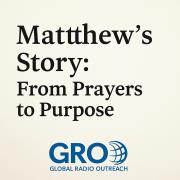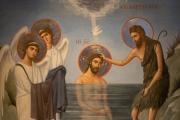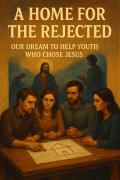Matthew’s Story: From Prayers to Purpose
(For safety reasons, “Matthew” is not his real name.)
Matthew grew up in in a Muslim country and a muslim family. Faith was part of everything, from morning prayers to how the family lived each day. “It was just how life was,” he says. “Everyone around me did the same. I never really questioned it.”
He prayed, fasted, and followed every custom he was taught. But even with all that, something always felt missing. “I believed in God,” Matthew says, “but He felt far away. I wanted to know Him, not just follow rules.”
That feeling stayed with him for years, until one day, a new friend began to change his life.
Matthew met a kind man from a local church who owned a small business nearby. They often talked about work, family, and life. “He never argued about religion,” Matthew remembers. “He just listened. And when he talked about Jesus, it was like he was talking about someone he actually knew.”
Over time, that friend invited Matthew to church. He went quietly, just to see. “I didn’t plan to believe anything,” he says with a laugh. “I just wanted to understand why these people seemed so peaceful.”
During one service, the pastor read a verse that stuck in Matthew’s mind:
‘Come to Me, all you who are weary and burdened, and I will give you rest.’ (Matthew 11:28)
“It was like those words were for me,” he says. “I realized I’d been trying so hard to please God, but I never felt peace. I wanted the rest Jesus talked about.”
That night, Matthew prayed for the first time in his own words. “I told God, ‘If Jesus is real, please show me.’”
In the weeks that followed, Matthew says something began to change in him. He felt drawn to read the Bible and talk more with his Christian friends. Slowly, he came to believe that Jesus truly is the Son of God.
“It wasn’t sudden,” he says. “It was like a light turning on, a little bit brighter each day.”
But when his family found out he had become a Christian, things became difficult. “They were angry and hurt,” Matthew says quietly. “They told me not to come home. Since then, we haven’t spoken.”
He still prays for them every day. “I love them,” he says. “I just want them to know the peace I found.”
Over time, Matthew started helping at the church, greeting people, cleaning up, and reading the Bible with new believers. And Church gave him shelter. He began to see how many others in his community were searching for answers just like he once had.
Then, one day, I met him and after atleast 20 meetings, I told him about Global Radio Outreach (GRO), a ministry that shares the message of Jesus through radio and online broadcasts. “As soon as I heard about it, something clicked,” Matthew says. “I thought, That’s how I can reach people like me.”
Matthew had always loved listening to the radio growing up. “Late at night, I’d turn it on and listen to voices from faraway places,” he says. “Now I get to be one of those voices.” He don’t like the fact that radios are gone now-a-days.
We are meeting almost everyday to train him how to talk and preparing topics to talk. He’s learning how to record, speak clearly, and share messages that answer questions about Jesus in a gentle and respectful way. But he is scared and I understand. I would be crying. That’s a lot of responsibility.
“I’m not on the air yet,” Matthew says, “but I’m getting ready. I want to tell people that God isn’t far away, He’s near. You can know Him personally.”
He plans to speak in Bengali, his heart language, and share simple Bible truths with listeners who may be secretly curious about Jesus.
One verse he keeps on his desk gives him courage:
‘Behold, I stand at the door and knock. If anyone hears My voice and opens the door, I will come in.’ (Revelation 3:20)
“That’s what Jesus did for me,” Matthew says. “He knocked, and when I finally opened my heart, He came in.”
Matthew’s family still doesn’t talk to him, but he hasn’t lost hope. “I believe one day, they’ll understand,” he says. “God’s timing is perfect.” And now he has a small income source from my me which eventually given by you GRO family.
Through Global Radio Outreach, Matthew’s story is becoming a message for others, proof that God is still reaching hearts in quiet, powerful ways.
As the Bible says:
“Their voice has gone out into all the earth, their words to the ends of the world.” (Romans 10:18)
And soon, Matthew’s voice will join that chorus — sharing hope, peace, and the truth of Jesus across our country.
Read more








